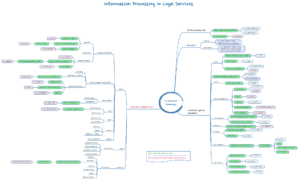Map of fundamental technologies in legal services
Dialogue is pleased to publish Map of fundamental technologies in legal services by Michelle Mahoney, Executive Director of Innovation with King & Wood Mallesons. It’s a valuable contribution and educational resource, not least because to my knowledge, this map is the only one of its kind. Readers’ views on the Map’s utility and ways to improve it are invited.
The key benefit of the Map is its helicopter view of the ‘big four’ technologies – AI, blockchain, enterprise systems (i.e. databases) and pre-programmed code – and their many applications in legal services, e.g. document automation, expertise automation, legal research, matter management, all aspects of practice and client management, due diligence and e-discovery.
The need for a map came to light in preparing learning resources for the Fundamental Technologies Shaping Legal Services subject in the College of Law’s Master In Legal Business.
Michelle writes, there is a good deal of talk about innovation in law. Many external forces are driving recognition of the need for change and transformation. Back in 2015 the World Economic Forum focused attention on the fact that the third industrial revolution, based on the automation of production using electronics and information technology, is transitioning to the fourth, known as the digital revolution. This is manifesting in the digital transformation of industries, enterprises and client experience.
This digital revolution is evolving at an exponential rather than linear pace with technologies enabling the merging of physical, digital, and biological assets. These pervasive phenomena are fundamentally altering the way we live, work and relate to each other.
The digital revolution is unique in its velocity, scope, and systems impact. It is disrupting almost every industry and causing us to hear about the importance of innovation and digital capabilities daily. Enterprises are responding to this landscape through a variety of digital strategies:
- increasing productivity – reducing the operational costs to deliver services or products;
- maintaining relevance – augmenting traditional products and services with digital to meet the evolving client needs; and
- future-ready – purely digital plays seeking to serve emerging and future client needs and the new patterns of behaviour.
Historically, the knowledge economy has used knowledge workers to combine information and expertise to create knowledge and services. The legal services industry is a prime example of this. Given the nature of legal work, the digital revolution is bringing with it technologies that are transforming legal service delivery.
Digital fluency in legal technology is critical for everyone in legal services as it increasingly becomes an enabler shaping the legal industry. Given the range and rate of proliferation of the technologies we are encountering, I have created a Fundamental Technologies Map. Click the graphic to enlarge and also download the Map.
The Map is designed to help make sense of the trends we are observing:
- an increasing number of legal technology offerings;
- the increasing effectiveness of legal technologies;
- emerging new categories of legal technology;
- the layering and combining of fundamental technology capabilities; and
- the maturation of machine learning, natural language processing and deep learning artificial intelligence.
Given the exponential nature of the technologies, the Fundamental Technologies Map can only depict the landscape at the current point in time. No doubt, it will require periodic updating to ensure it is mapping the enabling technologies as they emerge. Many of the AI applications are designed to be combined. Therefore I have shown examples of products for a particular capability, but note many products use a combination of AI techniques.
The example products are just that, examples in a product category, rather than best-of-class or the only product in that category. They have been included to help improve digital fluency through familiarity with vendors and in-practice applications.
For those who saw the potential of the third industrial revolution to facilitate behavioural change using technology in legal services, this digital revolution should renew your belief that technology can truly transform to the benefit of clients and service providers.
Author
Michelle Mahoney is the Executive Director of Innovation at King & Wood Mallesons and a member of the firm’s Executive Leadership team. A serial intrapreneur with a strong global network, Michelle has a track record for maximising technology, transforming business and innovating.
Michelle is a member of the College of Law Program Board for the new Master in Legal Business and is Co-Teaching Fellow of the Fundamental Technologies Shaping Legal Services subject.
Michelle may be contacted on michelle.mahoney@au.kwm.com.
More on related topics
Six key questions for understanding legal technology developments by Peter Campbell, Director: Client Solutions, Hall & Wilcox




Hi. I commend you for getting this started but I think the mind map is too complicated to be of much use and it seems focused around technological processes rather that legal functions. I would start again and build it more around user needs with the technology coming at the outside.
Thanks for the tip of the hat to Catalyst but there are too many end points that cover the same functions. Relativity, Catalyst, Ringtail and Exterro are all trying to solve the same functional issues.
I think you can simplify the map quite a bit if you take this approach.
JT
Hello John, George Beaton here. I am the Founder and Curator of this blog and Michelle’s co-teaching fellow in the College of Law’s Fundamental Technologies Shaping Legal Services subject.The Map and accompanying post are primarily intended to be learning resources for our – and other – students. As the subject name implies, it is is about the technologies, not ‘user needs’; several later subjects will address users and their needs. We see where you are coming from and have added to the post to improve the clarity of purpose. Thank you for your interest and comment.
Hi Michelle – map is a great initiative on your part, but unfortunately when I click on it to enlarge, it instead goes to a dead link? Hopefully you can rectify this…
Anneliese, apologies, this bug is now fixed
Regards
George
I loved this blog. The drive to digital to better serve customers is gathering momentum at corporations. Law departments will digitize or develop what Michelle calls ‘digital fluency’ to support the speed of business in the future.